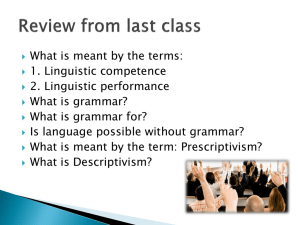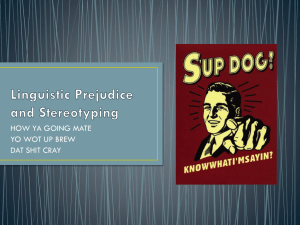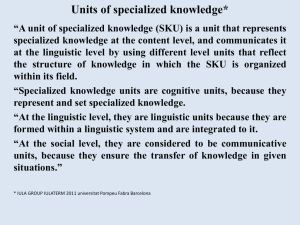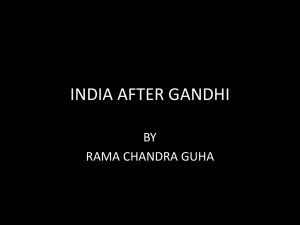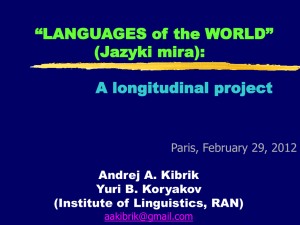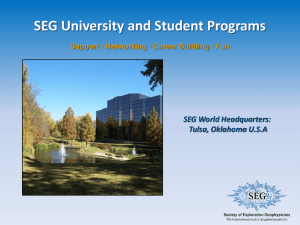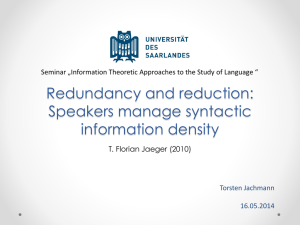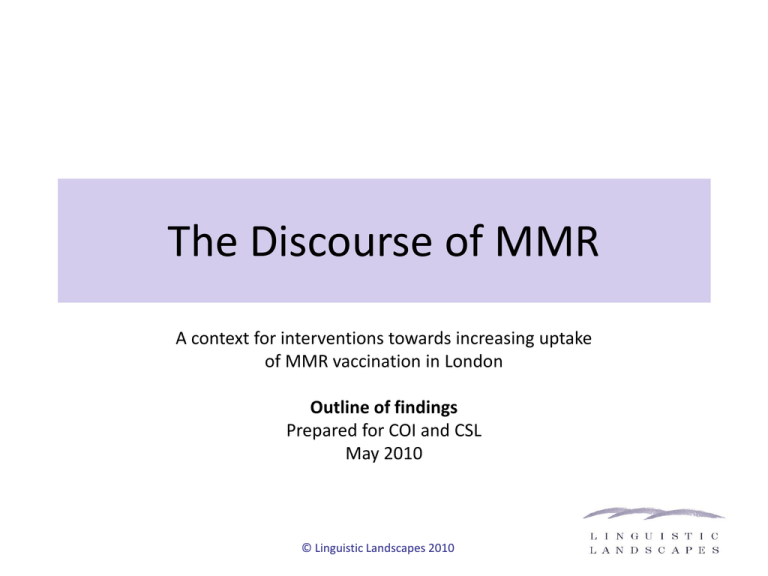
The Discourse of MMR
A context for interventions towards increasing uptake
of MMR vaccination in London
Outline of findings
Prepared for COI and CSL
May 2010
© Linguistic Landscapes 2010
About this document
• This document records the main findings from part
of a project commissioned from COI by
Commissioning Support for London, looking at the
public language around MMR vaccination
• It is designed mostly for those who saw the original
presentation, but also to allow access to the
information to others who might be interested
• It outlines methods and main findings, with some
comment on how these could be used
• If you have comments or queries after reading this,
please contact Jacqui Kean at COI:
jacqui.kean@coi.gsi.gov.uk
© Linguistic Landscapes 2010
Context
The project:
Linguistic Landscapes:
• This analysis was part of a wider
project carried out by COI to
advise Commissioning Support
for London about how to improve
MMR vaccination rates in London
• The original target group was
higher SEG (socio-economic
group) parents/carers; later in the
project this was extended to
lower SEG parents/carers and a
small amount of additional
analysis carried out
• The work was carried out in
March/April 2010
• We provide advice for businesses
and organisations through
detailed analysis of language in
public arena and within
organisations
• Our methods are based in
linguistics, discourse analysis and
other language sciences
• This is not an academic discourse
analysis; we provide applied
analysis projects designed to
address specific questions or
problems, in private and public
sector contexts.
© Linguistic Landscapes 2010
Our approach and purpose
• The focus of the project was to look at the public context
surrounding people as they make decisions about whether or
not to vaccinate against MMR
• It comprised an analysis of media and public discourse
relating to MMR drawn from media coverage,
communications content and focus group transcripts
• Discourse analysis examines how language constructs
meaning and understanding around a given issue – more later
on methods
• We wanted to identify common patterns; the themes and
linguistic constructions that help frame public understanding
and influence behaviour.
© Linguistic Landscapes 2010
Purpose within the overall COI project
This part of the COI project focused on language:
• To identify any characteristics of public discourse around
MMR that might be acting as a barrier to behaviour change
• To suggest how language can be used productively within
interventions to re-frame the debate or open up alternative
ways of behaving – for HCPs and parents
• To identify the potential for shifting the discourse, or
establishing a new discourse, perhaps creating a new
vocabulary for testing.
© Linguistic Landscapes 2010
What we did:
mapping the linguistic landscape
• Technical analysis of
language used around
MMR
1. Media
coverage
from past
year
2. Focus
group
transcripts
from past
work
4. PCT letters
3. Parents’
websites
DATA SOURCES
• Looking for patterns and
anomalies – largely qual
with some quant methods
• Comparison with
benchmark data where
possible
5. PCT websites
© Linguistic Landscapes 2010
• Some comparison of
media language pre- and
post-Wakefield verdict
Main and additional analysis:
higher and lower SEG media
•
Main analysis:
– Higher SEG media, subjected to full analysis – quant (corpus work) and qualitative
review ‘by hand’ to add depth and meaning
– Media coverage (UK and London) over past year, media with higher SEG readerships – c
140 articles
– Additional reviews of other data i.e. PCT letters, websites, mumsnet etc (as listed earlier)
– The findings of the main analysis have structured this presentation
•
Later addition of lower SEG media (only) after the main analysis
– Preliminary snapshot analysis
– Media coverage (UK and London) over past year, media with lower SEG readerships – c
35 articles (analysed just via corpus analysis, c.f. 85 analysed in this way from original
higher SEG data set)
– Limited to a corpus review – this kind of analysis shows major patterns and often throws
up differences that might need further investigation
•
This document is therefore based on the original work, with additional comments
which pull out major areas of similarity (many of these) and differences (a few of
these) between lower and higher SEG media.
© Linguistic Landscapes 2010
A little more about methods:
‘discourse analysis’
• Discourse analysis (DA) is a method where language is analysed in close
detail, in its social context. DA looks at the way language is used, what
function or effects it achieves, and how it does this.
• DA is based on the idea that language is not a transparent medium
through which we talk about a fixed ‘reality’, but that it has definite
effects. For example, in having names for some ideas and not others, we
collectively make some things ‘real’ and concrete and others hard to see
or refer to; language highlights some things and effectively hides others
• DA looks at how language is used – for example to represent the world, to
negotiate relationships between people, or to make a coherent and
meaningful statement or argument
• Most DA is done qualitatively i.e. through systematic but non-numeric
analysis. However, we sometimes use a more numbers-based approach to
help the analysis known as corpus linguistics .
© Linguistic Landscapes 2010
A little more about methods:
‘Corpus linguistics’
• Corpus linguistics is one method used within DA – it means the computerassisted analysis of large amounts of text data. It allows us to see patterns
in the data e.g. words which often occur together; and to compare
different data sets e.g. higher and lower SEG media
• Using this method we can also compare the language we are interested in
with ‘general’ language use – so we can see what’s specific to our data.
For example, we can identify words which appear unusually often,
compared to a huge reference ‘library’ of naturally-occurring language.
• Used alone, corpus linguistics gives a broad but relatively shallow
overview of patterns and features. It usually needs to be followed by
qualitative analysis ‘by hand’, to understand what these patterns mean.
We were able to do this here for the main analysis (which included higher
SEG media) but not for the additional analysis of lower SEG media.
© Linguistic Landscapes 2010
How to use these findings:
rationale for usefulness
• The rationale for usefulness of this analysis is this:
– Familiar language patterns are a resource we all draw on to help make
sense of the world and to talk about our experience. So looking at
what is ‘out there’ in public language shows us which ideas and ways
of talking are in circulation; they do not fix what people can think, say
or do, but they have an influence. (Think about how we now know and
can draw on the idea of ‘de-toxing’ in a wide range of contexts – a very
recently emergent idea and word, extended dramatically from its
original scientific roots)
– Analysing public discourse shows us the dominant ideas or tensions
out there, into which ‘comms’ or ‘messages’ drop. The public
discourse forms the context in which they are seen and evaluated; the
baggage that people bring when they encounter a specific leaflet, or
have a specific conversation with their HCP
– SO – looking closely at this gives cautious indications about what
might be successful ways to communicate on a particular issue.
© Linguistic Landscapes 2010
How to use these findings:
limitations of the analysis
• The limitations of these methods include these:
– We can only ever look at so much data; it is always a selection
– Corpus linguistics gives some connection with statistical analysis, but it gives
breadth rather than depth (so needs to be combined with qual analysis too)
– DA is primarily qualitative and like all qual research it is therefore
interpretative. It is systematic and based firmly in data, but ultimately the
researcher(s) must make interpretative judgments and recommendations
– So we hope and trust this is a useful perspective – but it is best used with
caution; especially, looked at in the light of other things you know. We do not
offer this as a complete or definitive ‘answer’ but invite you to allow it to open
up new ways of thinking about familiar problems.
• In addition, here we must be cautious when comparing implications for
higher and lower SEG audiences, since the two data sets and analyses
were not directly comparable
© Linguistic Landscapes 2010
Findings: Headlines
© Linguistic Landscapes 2010
Headline findings
• MMR sits at the intersection of several significant ‘ideological’ fault lines
– The changing status of science and other forms of authority
– Gender politics
– Class politics
• MMR itself has certain characteristics that amplify or precipitate these
tensions
• It is no wonder that it is politically and practically a ‘hot’ and difficult issue
• HCPs and parents alike are caught in a seemingly intractable conflict
• Doing more of the same seems unlikely to have any effect.
© Linguistic Landscapes 2010
Headline solutions: some early ideas
• Must ‘turn down the temperature’ of this discourse
• There is no point in shouting the same messages louder; we need different
conversations
• Engage in dialogue – properly. Conversations, not ‘messages’
• Construct a different relationship between health care providers/the
institutions behind them and parents, esp. mothers
–
–
–
–
not parent/child
nor a gendered asymmetry of power
but an adult-adult, respectful relationship
and/or use a more human approach, replacing institutional authority with
peer authority.
© Linguistic Landscapes 2010
The cultural tensions simmering
beneath the MMR discourse
© Linguistic Landscapes 2010
Ideological tensions:
the ‘big’ cultural context
•Science and
rationality; logic,
reason, evidence,
‘facts’
•Irrationality; myths,
stories, ‘scares’, faith,
belief
•Establishment
authority: top down,
‘monologic’ voice
•‘The public good’ –
an intellectual
construction
Vs
.
•Emerging authority;
peer-to-peer
authority; ‘dialogue’
•Individual, basic,
emotional, human
needs
© Linguistic Landscapes 2010
Ideological tensions:
these are gendered in our culture
•Science and
rationality; logic,
reason, evidence,
‘facts’
•Irrationality; myths,
stories, ‘scares’, faith,
belief
•Establishment
authority: top down,
‘monologic’ voice
•‘The public good’ –
an intellectual
construction
Vs
.
•Emerging authority;
peer-to-peer
authority; ‘dialogue’
•Individual, basic,
emotional, human
needs
© Linguistic Landscapes 2010
What do we mean here by ‘gendered’?
• We don’t mean literally male and female people
• But certain ways of speaking and behaving in the world are
associated in western cultures with the two genders
• Crudely: science, rationality, public life and the exercise of
power over others are ‘coded’ masculine; while emotion,
private/domestic/family life, magic, and being less powerful
are ‘coded’ feminine
• This means that women can and do speak in ‘masculine’ ways
and vice versa
• Or someone’s institutional role may be so ‘coded’ that it
overrides their actual sex or gender
• This does not mean these codings cannot be or are not
challenged – but they create an almost-invisible cultural
backdrop to how we interpret the world.
© Linguistic Landscapes 2010
These ideological tensions are played out
right across the MMR discourse
•Language of science and
rationality; logic, reason,
evidence, facts
•Language of irrationality; myths,
stories, scares, foolishness, faith,
belief
•Generic authority figures;
culturally coded male
•Establishment ‘voice’;
authoritative, top down,
monologic
•Middle class, educated*
•‘The public good’ – an
intellectual construction
•Individualised, specific women
Vs
.
•No dialogue between ‘authority’
and parents
•The educated middle classes who
refuse MMR are class traitors*
•Visceral drive to protect your
children – individual, basic,
emotional, human
* This less evident in lower SEG data
© Linguistic Landscapes 2010
How this looks across different
data sources
1.
2.
Media coverage
Parents’ websites
3. Focus group language
4. PCT letters
5. PCT websites
© Linguistic Landscapes 2010
1. Media: key language features
• Significant link between the
terms ‘MMR’ and ‘autism’
• ‘The (misguided) middle
classes’ vs. ‘the common
good’
• Emotionally charged
metaphors esp. fire, natural
disaster and warfare
• Pro-MMR arguments focus
on
– Evoking danger/threat
• Fear as the central emotion;
also violence and anger
• ‘Rational experts’ vs.
‘emotional mothers‘
• And on
– Numbers
– Authority/expertise/
reputation
– The ‘public good’*
– Parental/peer authority (in
lower SEG media)
* This less evident in lower SEG data
© Linguistic Landscapes 2010
autism=MMR=autism
• ‘Autism’ (and related forms)
highly over-represented in
MMR articles
• ‘Safe/ safety/ protect’
(against disease) far less
common
• Some negation (‘there is no
link between MMR and
autism’) BUT it is known
that co-occurrence
reinforces the very thing
that is being negated
© Linguistic Landscapes 2010
The link with
autism IS the
public context
for any
communication
about MMR: we
cannot ignore it
MMR = a discourse of fear
• Emotionally charged metaphors esp.
fire, natural disaster and warfare
o
“Unlike most scientific controversies which flare up
and die away, however, this one has simmered for a
decade - and may now be fired up again by the
preliminary verdicts in the GMC case.”
(Independent)
o
“Wakefield ... published his research ... which
unleashed a tsunami of fear about MMR.” (Times)
“His research paper ... sent shockwaves across the
world of medicine and into the homes of families”
(BBC News)
o
o
o
o
“I was there when Wakefield dropped his
bombshell” (Independent)
“The Lancet knew it had a potentially explosive
paper on its hands.” (Independent)
“...battle over the safety of the MMR vaccine”
(Times)
© Linguistic Landscapes 2010
This tendency
more pronounced
than in average
media coverage:
reflects the
location of MMR
across ideological
tensions and fault
lines
Rational experts vs. emotional women
•
Expertise, numbers, ‘evidence’ and
‘experts’ pitted against ‘myth’, ‘scare’,
emotion, fear, ‘panic’ (emotion implicitly
criticised in higher SEG media; less so in
lower)
•
NB media text talks about ‘parents’,
‘mums and dads’ etc – but pictures,
quotes and testimonials overwhelmingly
feature mothers
•
Other signs of a ‘gendered’ discourse
clearly present – vaccination constructed
as invasive, penetrative – though only
rarely explicit:
“MMR was a virility symbol. The State said: We
will pump what we like into your children and
you will thank us for it." When parents said:
"Thanks, but no thanks", the statist consensus
turned nasty. (Scotland on Sunday)
© Linguistic Landscapes 2010
On one level
playing out old
stereotypes;
women ‘letting
emotion get the
better of them’
But also reflecting a
real clash of
systems of value
Generic ‘authority’
but individual mothers
• ‘Experts’ are generic
– institutions and
faceless figures
– professors, consultants,
specialists, experts,
scientists
– usually not pictured
– generic categories;
rarely individualised
– (more individualised in
lower SEG media – via
human interest
narratives)
• ‘Mothers’ are
specific, pictured
and individualised
© Linguistic Landscapes 2010
‘The (misguided) middle classes’
vs. ‘the common good’
• MMR poses a cultural paradox:
educated people are rejecting a)
science and b) the common good
‘…middle-class twits like
Joanne pottering around the
kitchen brewing up potions‘
(Mail)
• Provokes anxiety and some
vicious attacks e.g. Mail
• Reflected in women's own
language – ‘I’m not an evil
mother’
[The parents] are middle class
and university educated, but
they are behaving like
morons. (Mail)
One correspondent - a highly
educated and intelligent woman asserted that girls have died in the
US from the vaccination, and
implying that profit-seeking drug
companies (with the connivance of
governments, presumably) were
prepared to kill our kids in order to
make money. (Times)
© Linguistic Landscapes 2010
David and Goliath: but
a minor discourse
• Wakefield and his
supporters set against the
might of the establishment
• ‘Refuser’ parents as ‘brave’
loners against the system
• But NB ‘brave’ also used
about those who choose to
vaccinate
Wakefield was a lone dissident, bravely
defying the mighty medical establishment.
[ascribed] (Independent)
[Radio presenter] Barnett [was]
concerned to bolster the position of
those brave parents who refused to
vaccinate. (Times)
© Linguistic Landscapes 2010
Media 25th Jan – 2nd Feb 2010: immediately
before and after the Wakefield verdict
•
[NB pre- and post- data sets not directly comparable, so we need caution in
interpretation. Also this only analysed for higher SEG data]
• Some features:
– Focus shifts to Wakefield, not disease; not surprising
– ‘MMR’ now linked with ‘safety’ (despite panel’s explicit
statement that this was about professional ethics, not
safety of MMR)
– Narrative of a ‘new beginning’
• BUT
– Still evidence of the gendered discourse as before
– ‘Authority talk’ used to establish the authority of the
hearing and thus the renewed pro-MMR position.
© Linguistic Landscapes 2010
Media: avoiding the crunch?
• Interesting avoidance of
direct obligation directed at
parents
• It is institutions that ‘should
and ‘must’
• Obligation is indirect re
parents – ‘children should
be immunised…’
• Govt sometimes accused of
‘bullying’
© Linguistic Landscapes 2010
Media
unwilling to
take an
unpopular and
politically
sensitive
position?
Headline comparison: main similarities
between higher and lower SEG media
• Main similarities:
– Safety and danger still at core of the discourse,
and a lot of ‘negative talk’ (‘bad’ and ‘worst’)
– The same key figures (parents, children, scientists
etc) appear in both
– Shared metaphors – e.g. fear is fire, controversy is
battle, disease is fire etc
© Linguistic Landscapes 2010
Headline comparison: main differences*
between higher and lower SEG media
•
•
•
•
•
MMR is treated as more relevant to higher SEG readers, with five times as much coverage
over the same period (data sets were drawn in same way for each). Article length is also
shorter in lower SEG data.
‘Autism’ as a term even more evident in lower SEG data ( NB not clear why this is so).
Interestingly, lower SEG data has metaphors for autism (darkness, absence – ‘the lights had
gone out’).
Less evidence of a sense of angst, worry and anxiety in lower SEG than in higher SEG:
‘anxiety’, ‘vulnerable’, ‘victim’, plus ideas around ‘worry’, are seen unusually often in higher
SEG media, but not in lower SEG, when compared to a reference language bank
Higher SEG media seems more concerned with ’accuracy’ of claims re MMR; lower SEG with
their moral rightness or wrongness
Higher SEG media refers itself to the role of the media - there is a discussion in the media
about the discussion in the media. This did not occur in the lower SEG media coverage
•
(cont…)
•
*NB see notes earlier re methods and how far we can rely on this comparison – it is indicative only
© Linguistic Landscapes 2010
Headline comparison: main differences*
between higher and lower SEG media cont.
•
•
•
•
•
Lower SEG media uses simpler language. The language is less varied than higher
SEG data, and there is less use of Latinate terms e.g. ‘immunisation’ (as we might
expect). It is more colloquial – ‘kids’ and ‘mum’ and more conversational e.g.
‘Well, [Wakefield] didn’t stand a chance did he?’ (Mirror)
Lower SEG features many more human-interest stories: e.g. we see more use of ‘I’
and personal names compared to higher SEG. There is more reference to kinds of
family members in lower SEG than higher SEG, also suggesting human interest
stories.
Parents’ testimonials are an important way that arguments are made or presented
in lower SEG (vs. e.g. use of numbers, authority figures or scientific arguments in
higher SEG); also doctors are more often personalised.
There is less focus on the collective good - ‘protect’ and ‘protected’ always occur
with ‘children’/‘kids’ in lower SEG; while in higher SEG media this also occurs with
‘population’ or ‘individuals’. In addition, lower SEG data does not include abstract
agents like ‘nation’, ‘state’ and ‘society’.
*NB see notes earlier re methods and how far we can rely on this comparison – it is indicative only
© Linguistic Landscapes 2010
2. Focus groups and interviews:
frustration and emotion on both ‘sides’
• Many parallels in focus group
discourse with that in media
• HCPs present MMR vaccination
as an unambiguous good; are
frustrated by those who refuse
• MMR refusers borrow language
of rationality but are essentially
(and often explicitly) irrational
“it’s totally irrational”
(Depth 4)
“My aim is to get a hundred percent of
children vaccinated.” (Practice Nurse)
(Moderator) “They also don’t
connect measles with MMR...”
(Respondent) “Oh, bloody hell.”
(Immunisation Officer)
“We all know that nature is much better at
all of this stuff than we are. The fact that
people way up there who are dealing with
all of this stuff think themselves so clever,
and they are very clever, but I don’t think
they’re cleverer than nature is.” (Depth 4)
© Linguistic Landscapes 2010
MMR specifically amplifies the ideological
tensions; no wonder parents resist ‘logic’
•Discourse of
irrationality; myths,
stories, scares,
foolishness, faith,
belief
•Discourse of science
and rationality; logic,
reason, evidence (NB
also careful and
cautious)
•Individualised,
specific women:
mothers
•Generic authority
figures (coded ‘male’)
•Establishment
‘voice’; authoritative,
top down, monologic
•Middle class,
educated
•‘The public good’ –
an intellectual
construction
Vs.
•Personal voice
•Middle class
educated women as
class traitors– ‘they
should know better’
•Visceral drives re
protecting your family
– individual, basic,
emotional, human
© Linguistic Landscapes 2010
MMR specifically feeds an
‘irrational/female’
discourse:
•Autism itself is
constructed as strange
and unknowable
•Immunisation - literal
and metaphorical
penetration – ‘invasive’
and ‘barbaric’
• ‘It’s different when
it’s your child’: deep
fear of regret, blame,
lack of forgiveness
HCPs frustrated: they want to shout the same
things louder, not change mode of engagement
Private responses of
HCPs look like this:
•‘Unscientific’ level
of certainty (“There
is no link with
autism”)
•Mechanistic
construction of
parents; ‘If only they
had the information
and good access
they would comply’
•Exasperation and
impatience with
‘irrationality’
•Discourse of
irrationality; myths,
stories, scares,
foolishness, faith,
belief
•Discourse of science
and rationality; logic,
reason, evidence (NB
also careful and
cautious)
•Individualised,
specific women:
mothers
•Generic authority
figures (coded ‘male’)
•Establishment
‘voice’; authoritative,
top down, monologic
•Middle class,
educated
•‘The public good’ –
an intellectual
construction
© Linguistic Landscapes 2010
Vs.
•Personal voice
•Middle class
educated women as
class traitors– ‘they
should know better’
•Visceral drives re
protecting your family
– individual, basic,
emotional, human
Breakdown: the absence of real
dialogue
“...if you go to the
clinic they’ll
•Discourse
of science
just say, why hasn’t
had his logic,
and he
rationality;
vaccinations, and
they’llevidence
start (NB
reason,
scaring you, saying
there isand
also careful
measles around.cautious)
They kind of
take that approach with you.
They don’t say •Generic
‘have youauthority
got
(coded
any concernsfigures
about it,
or ‘male’)
why...’ . I don’t•Establishment
find that that
helpful, really.”
(Depth
1)
‘voice’;
authoritative,
top down, monologic
•Middle
“You don’t actually need
to goclass,
into all of
educated
this. That could have been small and
even more punchy.•‘The
You know,
public‘Don’t
good’ –
leave your child’s health
to
chance.
an intellectual Just
get the immunisation!’”
(Immunisation
construction
Officer)
•Discourse
of
“[the doctor]
turned round
and she said ‘Oh some
irrationality;
myths,
people have been like, you know, looking at what
stories, do
scares,
these celebrities
and think that they can come
into herefoolishness,
and …’ and faith,
that was a little rant. And I
was likebelief
‘oh my God how can you say this to
me?’ I am
a mother, you see my child, you see
•Individualised,
that Ispecific
am concerned.
women: I am not crazy, I am
speaking
mothersto you nicely” (Depth 4)
Vs.
•Personal voice
“Just basically
•Middle
class them trying to convince us to
allow my little
girl as
to have it but obviously I’ve
educated
women
raised
the same
class
traitors–
‘theyissues that I’ve raised here
and,know
you know,
should
better’they can’t give you that
information [re: the risks of MMR] because
•Visceral
drivesthey
re don’t know it themselves.
half the time
protecting
your to
family
You know,
me, they’re like robots
– individual, basic,
basically” (Depth 7)
emotional, human
© Linguistic Landscapes 2010
3. Parents’ (i.e. mums’) websites
• Amplified version of the tensions seen in other areas
• Highly emotional esp. mumsnet.con; MMR a highly contested subject
• Gendered – one poster ‘accused’ of being male through tone of his/her
argument
• Mums’ own research can be deep and highly specific – they post academic
articles for others to read
• Scathing about NHS ‘party line’ - and brutally to the point: “Measles being
dangerous does not make MMR safe”
• Longing for real information, but within a dialogue – have to look to the
peer group for this, but room for DH to take a different approach:
I can see why they might not want a measles epidemic, but if tactics so far haven't worked
to increase numbers then perhaps they should try another. They have been shouting the
MMR is safe line for years, Wakefield's reputation is now destroyed. If people still refuse
MMR then maybe they need to look at why and approach the public differently
(mumsnet.com post 24th Feb 2010)
© Linguistic Landscapes 2010
4. PCT letters: seem unlikely to connect
with parents
• Autism is backgrounded; simply ignores the major context for
parents re MMR
• Obligation prominent; pressurising without recognising
where parents start from
• Cumbersome and stilted; poor grammar, spelling and
punctuation could make the sender seem untrustworthy to
educated parents
• In addition: some problems common in public sector comms:
– Sense of self-absorption and lack of focus on the reader
– Concerned with own official discourse, not what will make most sense
to readers
– Clash between the private world of the parent and the public sphere
of health institutions
© Linguistic Landscapes 2010
5. PCT websites
• Again, most show little willingness to engage around parental
concern:
– ‘unfounded fears’ = dismisses concern without addressing it
– ‘MMR: the facts’: a common construction - implies there is ‘fiction’ –
not (for example) understandable confusion and consequent worry
– naturalisation and normalisation of MMR – ‘your baby will receive’…
no acknowledgement of choice/doubt
– talk about vaccination ‘take-up’ (as if of an opportunity) – not
vaccination ‘acceptance’ (more accurate in today’s climate)
• Again, considerable use of ‘authoritative’ healthcare discourse
in public-facing materials
© Linguistic Landscapes 2010
NB: people see all web material, not just
material directed at them
• Web searching ‘PCT name + MMR’ throws up internal/official
documents
– minutes, internal reports, policy documents etc
– often before patient-directed materials
– language of official documents likely to deepen tensions seen
elsewhere
• “High levels of parental refusal of MMR vaccination making targets hard
to attain despite wide coverage with offer of immunisation…”
• ‘Persuasive’ materials always have a context – this is one more
to consider.
© Linguistic Landscapes 2010
Implications for interventions:
first thoughts from the discourse perspective
© Linguistic Landscapes 2010
Implications for interventions:
first thoughts from the discourse perspective
• Autism IS the context
– Need to consider benefits of open acknowledgement (basis for
dialogue) vs. dangers of perpetuating this link – deepening this
‘groove’ in the discourse
• We must turn down the temperature in this arena – necessary
to lay the groundwork for different conversations
– This topic has power and heat because it crosses significant
cultural/political fault lines – it is culturally ‘hot’
– There is no point in shouting the same messages louder – ‘fanning the
flames’ and entrenching positions
© Linguistic Landscapes 2010
Implications for interventions:
thoughts from the discourse perspective
• Engage in dialogue – properly
– Conversations, not ‘messages’
– Extrapolate from mediation, conflict management and negotiation; need first
to show adversaries that they are heard and respected by each other
• Construct a different relationship between health care providers (and the
institutions behind them) and parents, esp. mothers
–
–
–
–
not parent/child – ‘we know best’ – clearly not working
nor a gendered asymmetry of power – clearly retrogressive
BUT an adult-adult, respectful
and/or use a more human approach, replacing institutional authority with
peer authority (this suggestion comes from looking at the lower SEG media
data)
• NB implications for ‘behaviour change’
– BUT in HCPs and ‘authority voices’ – not just in parents.
© Linguistic Landscapes 2010
Media titles analysed
Higher SEG (ABC1)
Lower SEG (C2DE)
The London Evening Standard
The Metro
The Daily Express
The Daily Mail
The Guardian
The Times
The Independent
The Sunday Express
The Sunday Mail
The Sunday Times
The Independent on Sunday
The Observer
The London Evening Standard
The Metro
The Sun
The Daily Mirror
The Sunday Mirror
The Daily Star
The Daily Star Sunday
The News of the World
The People
The Sunday People
Source TGI : newspapers read by mothers of children age 1-4
© Linguistic Landscapes 2010
Linguistic Landscapes
19a Bell Street
Reigate
Surrey
RH2 7AD
UK
Tel/fax +44 (0)1737 246155
info@linguisticlandscapes.co.uk
45
© Linguistic Landscapes 2010

